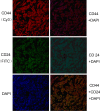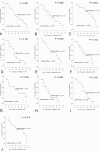CD44+/CD24- phenotype contributes to malignant relapse following surgical resection and chemotherapy in patients with invasive ductal carcinoma
- PMID: 22762532
- PMCID: PMC3432011
- DOI: 10.1186/1756-9966-31-59
CD44+/CD24- phenotype contributes to malignant relapse following surgical resection and chemotherapy in patients with invasive ductal carcinoma
Abstract
Background: Invasive ductal carcinoma is the most common type of breast malignancy, with varying molecular features and resistance to treatment. Although CD44+/CD24- cells are believed to act as breast cancer stem cells and to be linked to poor prognosis in some patients, the association between these cells and tumor recurrence or metastasis in all or some types of invasive ductal carcinoma is unclear.
Methods: A total of 147 randomly selected primary and secondary invasive ductal carcinoma samples were assayed for expression of CD44, CD24, ER, PR, and Her2. The association between the proportions of CD44+/CD24- tumor cells and the clinico-pathological features of these patients was evaluated.
Results: CD44+/CD24- tumor cells were detected in 70.1% of the tumors, with a median proportion of 5.8%. The proportion of CD44+/CD24- tumor cells was significantly associated with lymph node involvement (P = 0.026) and PR status (P = 0.038), and was correlated with strong PR status in patients with recurrent or metastatic tumors (P = 0.046) and with basal-like features (p = 0.05). The median disease-free survival (DFS) of patients with and without CD44(+)/CD24(-/low) tumor cells were 22.9 ± 2.2 months and 35.9 ± 3.8 months, and the median overall survival (OS) of patients with and without CD44(+)/CD24(-/low) tumor cells were 39.3 ± 2.6 months and 54.0 ± 3.5 months, respectively, and with both univariate and multivariate analyses showing that the proportion of CD44(+)/CD24(-/low) tumor cells was strongly correlated with DFS and OS.
Conclusion: The prevalence of CD44+/CD24- tumor cells varied greatly in invasive ductal carcinomas, with the occurrence of this phenotype high in primary tumors with high PR status and in secondary tumors. Moreover, this phenotype was significantly associated with shorter cumulative DFS and OS. Thus, the CD44(+)/CD24(-) phenotype may be an important factor for malignant relapse following surgical resection and chemotherapy in patients with invasive ductal carcinoma.
Figures


Similar articles
-
Predictive value of CD44 and CD24 for prognosis and chemotherapy response in invasive breast ductal carcinoma.Int J Clin Exp Pathol. 2015 Sep 1;8(9):11287-95. eCollection 2015. Int J Clin Exp Pathol. 2015. PMID: 26617852 Free PMC article.
-
The CD44+/CD24- phenotype relates to 'triple-negative' state and unfavorable prognosis in breast cancer patients.Med Oncol. 2011 Sep;28(3):745-52. doi: 10.1007/s12032-010-9530-3. Epub 2010 Apr 20. Med Oncol. 2011. PMID: 20405247
-
CD44/CD24 as potential prognostic markers in node-positive invasive ductal breast cancer patients treated with adjuvant chemotherapy.J Mol Histol. 2014 Feb;45(1):35-45. doi: 10.1007/s10735-013-9523-6. Epub 2013 Jul 9. J Mol Histol. 2014. PMID: 23835592
-
Evaluation of CD44+/CD24- and Aldehyde Dehydrogenase Enzyme Markers in Cancer Stem Cells as Prognostic Indicators for Triple-Negative Breast Cancer.Cureus. 2022 Aug 16;14(8):e28056. doi: 10.7759/cureus.28056. eCollection 2022 Aug. Cureus. 2022. PMID: 36120232 Free PMC article. Review.
-
Utility of CD44/CD24 in the Outcome and Prognosis of Oral Squamous Cell Carcinoma: A Systematic Review.Cureus. 2023 Aug 3;15(8):e42899. doi: 10.7759/cureus.42899. eCollection 2023 Aug. Cureus. 2023. PMID: 37664387 Free PMC article. Review.
Cited by
-
Continuous exposure to doxorubicin induces stem cell-like characteristics and plasticity in MDA-MB-231 breast cancer cells identified with the SORE6 reporter.Cancer Chemother Pharmacol. 2024 Oct;94(4):571-583. doi: 10.1007/s00280-024-04701-4. Epub 2024 Aug 24. Cancer Chemother Pharmacol. 2024. PMID: 39180549 Free PMC article.
-
Expression of Androgen Receptor and Cancer Stem Cell Markers (CD44+/CD24- and ALDH1+): Prognostic Implications in Invasive Breast Cancer.Transl Oncol. 2018 Aug;11(4):920-929. doi: 10.1016/j.tranon.2018.05.002. Epub 2018 May 31. Transl Oncol. 2018. PMID: 29843115 Free PMC article.
-
MicroRNA-34a functions as an anti-metastatic microRNA and suppresses angiogenesis in bladder cancer by directly targeting CD44.J Exp Clin Cancer Res. 2014 Dec 31;33(1):779. doi: 10.1186/s13046-014-0115-4. J Exp Clin Cancer Res. 2014. PMID: 25551284 Free PMC article.
-
Inflammatory Breast Cancer: The Cytokinome of Post-Mastectomy Wound Fluid Augments Proliferation, Invasion, and Stem Cell Markers.Curr Issues Mol Biol. 2022 Jun 17;44(6):2730-2744. doi: 10.3390/cimb44060187. Curr Issues Mol Biol. 2022. PMID: 35735628 Free PMC article.
-
Insights into the Role of Estrogen Receptor β in Triple-Negative Breast Cancer.Cancers (Basel). 2020 Jun 5;12(6):1477. doi: 10.3390/cancers12061477. Cancers (Basel). 2020. PMID: 32516978 Free PMC article. Review.
References
MeSH terms
Substances
LinkOut - more resources
Full Text Sources
Other Literature Sources
Medical
Research Materials
Miscellaneous

